A Book in Archery: “Kitāb fī rimāyat al-nišāb” – Mamluk Chivalry Manuscript Preserved at Staatsbibliothek zu Berlin (Landberg 42)
Gastbeitrag von Dr. Mohamed Ibrahim
The abundance of Muslims in their home region has greatly influenced their ability to conquer other countries. Their war science has been developing daily along with the evolution of weapons and their variety; what has been brought to us in this field is evidence of this. The great Islamic civilization has produced numerous scholars and writers who have written in a variety of fields, including the field of martial arts, through which they contributed to the advancement of military science. Numerous publications on the mobilization, management, financing, arming, equipping, and movement of armies have been produced by them; nonetheless, most works still require in-depth investigation, examination, and study.
The necessity of the Islamic nation’s physical preparedness was recognized by our first forefathers. Armed with a variety of weapons, they managed to breach the barriers and gain access to other countries. The God-sent messenger was eager to amass a vast array of weaponry, both offensive and defensive ones, as Allah, the Almighty says:
“﴿وَأَعِدُّوا لَهُمْ مَا اسْتَطَعْتُمْ مِنْ قُوَّةٍ وَمِنْ رِبَاطِ الْخَيْلِ تُرهِبُونَ بِهِ عَدُوَّ اللَّهِ وَعَدُوَّكُمْ﴾“ (Qur’ān, VIII/60)
This verse gives the divine order to arm the Almighty in order to fight God’s adversaries. Many war arts and letters about the leadership of armies, the organization and training of soldiers for combat, the use of swords, arrows, spears, and about equestrian skills have come down to us, especially from the Mamluk era. Additionally, there are other writings in the science of archery that discuss forms, required talents, skills, and instruments. Such manuscripts can be found in several local libraries such as the Egyptian House of Books, the Institute of Arabic Manuscripts, and some organizations that deal with difficult-to-count heritage books, as well as in libraries throughout the world in France, Germany, Turkey, and other countries. The majority of these manuscripts have one thing in common: most of them are unpublished and rest in the libraries‘ reservoirs unread, unstudied, unreferred to – until some critical scholar takes a close look and uncovers their mysteries.
The Mamluks relied on equestrianism as the foundation of their state, and the study of their literature shows that the general culture of the Mamluk era took great care of warfare and combat methods. On the other hand, this era’s nature as one marked by ongoing wars and conflicts is also revealed.
Analyzing private military documents reveals the Mamluks‘ particular interest in archery; in case of need, it is the first instrument of retaliation that allows the adversary to be struck from behind a curtain. The methods used to teach the Mamluks all archery techniques with bow and arrow are mentioned in the texts of these books. The rider needed to become an expert at riding, walking, running away, and had to pick up the various archery techniques – from landing to climbing and vice versa, from shooting at stationary, movable and moving objects to archery at seafaring boats, forts, and castles.
These manuscripts discussed the skill of archery used against enemies in war, archery at animals when hunting, and archery at play. They also discussed the cruelty, types, strings, varieties of bows and arrows, as well as the art of archery during the day and at night, each with its own bases and foundations. There are several techniques for gripping the bow, sitting, paying arrows, and other crucial tasks for each purpose.
Because of the significance of bow and arrow shooting in the Mamluk era – which differs greatly from other skills – special writings of this kind held a prominent position in those days. They handled the right equipment for the size of one’s body and the make-up of the organs, as well as a guide to everyone’s perfect archery technique and how it should be executed. The techniques in these documents also include making shooting instruments out of other materials, in order to prepare arrows and bows at the time they were thought to be required. As one of the martial arts, crossbow science has drawn the attention of several writers, and numerous works have arisen independently of each other, with their authors creating a story of the techniques and abilities of this science. Sovereigns and princes were eager to obtain these texts in order to become knowledgeable about the art of archery and to set themselves apart in this regard, particularly when it came to their own practices with bows and arrows in hunting, at play, or war.
Libraries and bookstores still have many unpublished archery manuscripts in their collections of priceless war documents that haven’t got enough attention to be studied or published. Similarly, the Staatsbibliothek zu Berlin (State Library at Berlin) holds an item in the manuscript collections of the Oriental Department, with the shelfmark Landberg 42, that constitutes one of the most significant and uncommon private archery manuscripts of the Mamluk era, the examination and publication of which is in the making. Anonymous author, as his name was obliterated on the opening page of the manuscript, and he is not mentioned on any of the manuscript’s pages. The defaced information in the manuscript’s opening and inside caused the Berlin library to inadvertently overlook its dating. However, a close examination of the title page provides some crucial details that help to understand how this text, which is comprised of 23 articles on 46 pages, relates to the Mamluk era. The text is written in Nasḫī script, black ink – only the titles of the inner parts are written in red –, and with 15–19 lines on a single page. This manuscript is a crucial source for crossbow shooting science. It is evident that we are properly moving toward multiple authors because of its significant role in the monarchy’s military domain, and it includes some examples of Mamluk bows and arrows.
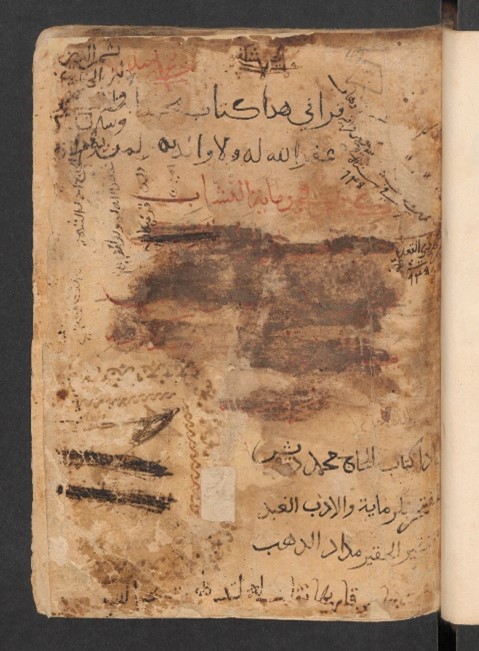
The first page of the manuscript. – SBB‑PK: Landberg 42, fol. 1r
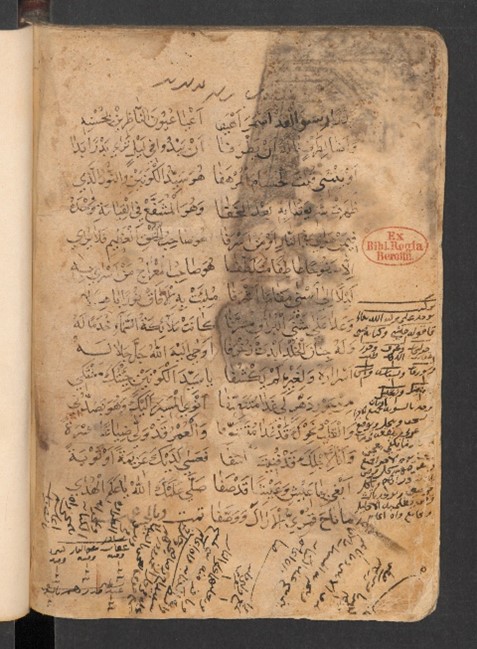
The last page of the manuscript. – SBB‑PK: Landberg 42, fol. 23v
Details of the version of the manuscript
Title: Kitāb fī rimāyat al-nišāb – A Book in Archery
Collection: Staatsbibliothek zu Berlin (Oriental Department)
Classmark: Landberg 42
Date: 8th–9th century AH / 14th–15th century A.D.
Number of folios: 23 (46 pages)
Number of lines per page: 15–19 lines
Dimensions of full page: 19,4 × 13,4 cm
Text area: 14–15.5 × 9 cm
Script style: Nasḫī
Paper color: yellowish
Colors and gilding: completed drawings, incorporating red, black, and green in addition to gilding
Binding: The Staatsbibliothek zu Berlin performed binding work on the manuscript to preserve and safeguard it; it does not have its original binding.
Paper Type: light brown, thick, soft, dark color
Because the manuscript leaves were cracking, restoration of the manuscript leaves – especially of the first page – had to be performed by adding supporting paper. Additionally, it demonstrates how one of the fluids spilled and smeared all the book’s pages, changing certain pages‘ colors but leaving the text and words unaltered. This suggests that the manuscript was written using a certain type of paper and ink.
Made in the Levant or Egypt.
The Author
The manuscript’s anonymous author is not identified by name on the first page, inside the manuscript board, or on the last page, nor did he register the transcript name for the text. Because he has not been numbered or given a name on any of the manuscript’s pages, the copier is similarly anonymous.
The owner and the date of copying
Actually, one of the most significant outcomes of this investigation is the identification of the manuscript’s author. Staatsbibliothek zu Berlin has held this text without identifying its owner or conjecturing about its author. The title page should have the book’s author on it; but the first line of the manuscript’s title is all that remains of the five-line written text there, which has been completely obscured by a black stretch to conceal it. However, if you closely examine this section, you will notice that there are some remaining words and letters hidden behind this blur. Numerous of them were made clear by the present study, which assisted in accurately determining the manuscript’s history and author identity.
The title of the document appears in the first line: “Kitāb fī rimāyat al-nišāb” (“A Book in Archery”). The words in the second line have been fully identified, despite the fact that it is entirely unclear: bi rasm al-maqar al-ʿĀlī, al-mawlawī (‘The honored, the high, the lord’), al-Amīrī, (‘The princely’). These are the titles that have helped to define and make plausible the Mamluk period. Although the third line is also entirely unclear, the study has managed to identify in it only two words: al-Maḫdūmī (‘The well-served’), al-Ašrafī, (‘The honored’), while the fourth line includes: Yalbuġā (al-Baha’ī?) (‘The Sovereign’) of Alexandria. There is only one word in the last and particular line: something like al-maḥrūsah. Even though the name Yalbuġā seems to be very clear, the next name seems to be somewhat unclear, referring to a series of fluctuations regarding this character’s reality. The monarchy’s sources revealed numerous emirs by the name of Yalbuġā who were associated with the city of Alexandria.
One of them is Prince Yalbuġa Al-ʿUmarī Al-Naṣirī Al-Ḫāṣakī (the commander in chief). There is also Prince Yalbuga al-Nasseri, who died in 776 AH / 1374–1375 A.D., one of Naṣir Hassan’s Mamluks. There is Prince Yalbuġa al-Yahyawī, about whom sources indicate that in the events of 740 AH / 1339–1340 A.D., he and Prince Baštāk Al-Naṣirī visited Alexandria City for a walk and fishing exercise, in accordance with the custom and the economic situation, and benefited the Alexandria traders community. They succeeded in solving the problems of one of Alexandria’s traders and helped the arms dealers: Through his mediation with Sultan Nasser Mohammed after his return from visiting the city, the arms trade and shooting were allowed to be re-practiced and the shooting ranges, which had been closed and not allowed to open, were reopened.
There is also Prince Yalbaġā Al-Bahā’ī, Sovereign of Alexandria in the Circassian Mamluk era, and it is likely to the present study that this manuscript is a special manuscript of him, Prince Yalbaġā Al-Bahā’ī: Deputy of Alexandria. He was Prince Yilbuġa bin Abdullah, Saif al-Dīn, Bahā’ī, Zahirī, who passed away at the age of 70 in Jumada I in 843 AH / October 1439 A.D. On 19th Rağab, 842 AH / 5th January, 1439 A.D., he was appointed deputy in Alexandria. He passed away during his tenure as Alexandria’s ruler, on 13th Jumada I, 843 AH / 22nd October, 1439 A.D. Mamluk accounts state that during the events of Rağab in 842 AH / January 1439 A.D., Sultan Ẓāhir Jaqqmaq deposed Prince Tamarbaī from Alexandrian rule and after his deposition, instead of him he placed Prince Yalbuġa Bahā’ī. Ten months later, in Jumada I in 843 AH / October 1439 A.D., he appointed prince Asanbuġā al-Ṵayārī as the deputy of Alexandria, replacing Yalbuġa al-Bahā’ī who had passed away. What this manuscript most likely attributes to him is that, according to Ibn Tagri Bardi, „He had attended jurisprudence and other sciences, wrote in appropriate style, was eloquent in Arabic, sweet speech, good lecture, reminiscent of the preceding days with an exquisite memory, and is one of the rarely known in his significance.“ Personal documents suggest that Prince Yalbuġa bin Abdullah Al-Bahā’ī Al-Ẓāhirī was involved in cultural life.
The manuscript’s owners
Nine entries in this book indicate possessions that have endured over the millennia, ranging from what is readable, recognizable, and clear to what is ambiguous, with or without design. Eight entries are included on the first, i.e. the title page, whereas the following, the first text page, has only one possession note on it.
The first note of possession is a black signature located in the top center of the first page, and is overlapping and entwined. It reads Ḥusāmi al-Aškīfanī [sic?]. (Fig. 1)

(Fig. 1) One of the Manuscript’s possession notes on the first page. – SBB‑PK: Landberg 42, section of fol. 1r
A red signature on the left side at the top of the first page indicates the second possession. Three connected words make up this possession signature, and they can be interpreted as follows: Ḥāj Waslān [sic?] (Fig. 2)

(Fig. 2) One of the possession notes on the first page in red. – SBB‑PK: Landberg 42, section of fol. 1r
The third possession note on the first page is on the far-left side at the top. Some of the words in the five-line text are unclear. It reads (Fig. 3): “ li Šams al-Dīn / ibn al-Ga [sic?] / bin walad [sic?] al-sunnī [sic?] / Waslan / Yawm [sic]

(Fig. 3) One of the manuscript’s possession notes on the first page by the name of Šams al-Dīn. – SBB‑PK: Landberg 42, section of fol. 1r
The fourth possession: This entry, which starts in the middle of the first page, has been written in two lines and put into Nasḫī, using black ink (Fig. 4), and reads:
– Qur’a fi haḏa kitab Muḥammad [sic?] ’What has been read in this book, Muḥammad’ [sic?]
– Ġafar Allah lahu wa liwālidaih wa liman [sic?] ‘May Allah forgive him and his parents, and who’ (who reads in it …) [sic?]

(Fig. 4) One of the manuscript’s possession notes applied on the first page in Nasḫī in black ink. – SBB‑PK: Landberg 42, section of fol. 1r
The fifth possession note is written on the right side at the top of the first page, in four lines of Ottoman script in black ink, much of which has been erased leaving just a few words remaining:
– birasam …al-wahhab / … [effaced] / wa liman qara’a fih / fi sanat … ‘Made for …al-Wahhab’/ … [effaced] / ‘and who reads in it / in the year …’
There is another text directly below this one, and in that text, the date appears in two lines with an outlet of the same line:
– fi šahr ḏī al-qiʿdah / sanat / 945 [sic?] ‘In the month of ḏī al-Qiʿdah / in the year / 945’ [sic?]

(Fig. 5) One of the manuscript’s possession notes applied on the first page bears the date ḏī al-qiʿdah 945 AH. – SBB‑PK: Landberg 42, sections of fol. 1r
The sixth possession: The Nasḫī script uses black to create a longitudinal text on the left side of the first page. It is written in five lines, but attempts to blur it have caused some of the text to vanish and the remaining text to appear blurred (Fig. 6):
The first line has totally vanished:
– … / al-ḥaj Aḥmad al-šahīr (bi ibn [sic?]) al-tag [sic?], al-Ḥanafī [sic?] / ġafar Allah lahu wa li wālidayih / wa liman qara’a fīhhim, / allahum Amīn.
‘… / Al-Haj Aḥmad known as (ibn [sic?]) and al-Tağ [sic?], al-Ḥanafī [sic?] / May Allah forgive him and his parents / and who reads them / Amīn.’

(Fig. 6) One of the possession notes on the first page by the name of Haj Aḥmad al-Ḥanafī. – SBB‑PK: Landberg 42, section of fol. 1r
The seventh possession note is written in four lines in black ink at the bottom of the first page. It probably refers to one of the later owners of the book because it is well-preserved and well written (Fig. 7). It says:
–haḏā kitāb al-Ḥaj Muḥammad Darwīš / al-muftḫar bi’-al-rimāyah wa’ al-adab, al-;ʿabd / al-faqīr al-ḥaqīr mudād al-ḏahab [sic?] qārihā tunāb lahū [?] lad[?] bi ḥubā[?] All[?].
‘This is the book of Ḥaj Muḥammad Darwīš / expert in archery and morality, the same / the poor, the humble, golden ink, [sic?] it is owned by who reads it [?] For [?] By love [? ] Of Allah [?]’

(Fig. 7) One of the manuscript’s possession notes on the first page by the name of Ḥaj Muḥammad Darwīš. – SBB‑PK: Landberg 42, section of fol. 1r
The eighth possession: The inscription appeared in two lines at the bottom left, inside a double-framed, braided, red box, but it has been entirely obscured by black ink, leaving no details visible. (Fig. 8)

(Fig. 8) One of the manuscript’s possession notes on the first page. – SBB PK: Landberg 42, section of fol. 1r
The ninth possession: This passage is written in six lines and is located on the first text page of the book, precisely beside the right margin. It was written in Nasḫī using black ink. It reads:
–intaqal bi al-ibtiyāʿ al-šarʿī / ila milk al-faqīr al-ragğī / ʿafwu rabihī ([?] al-wazīr [?]) / al-maḥfūf bi al-littf al-ḫaffy / ʿAbd al-karīm bin Baḫšī / al-Ḥanafī).
‘Transferred by a legal sales process / to the property of the poor, the anticipator/ May Allah forgive him ([?] the vizier [?]) / Surrounded by the hidden mercy of Allah / ʿAbd al-Karīm bin Baḫšī / al-Ḥanafī).’
This might also have been one of the deceased individuals to whom this book had been transferred.

(Fig. 9) One of the manuscript’s possession notes, the one applied in the right margin on the first text page, bears the name of ʿAbd al-Karīm bin Baḫšī. – SBB‑PK: Landberg 42, section of fol. 1v
The content
This book is organized into two parts: The first is an introduction by the author that includes a summary of the book, several verses from the Quran, and candid conversations about the prophet Muḥammad’s (PBUH) sayings about the meaning of fighting and jihad in Islam. It also exhibits references to archery and the months of the shooters and the words said during archery, and to the book’s first appearance. The second part of the book is divided into twenty sections that contain all the information about shooting with bow and arrow.
Work is in progress to verify the text of this manuscript, and it will be published soon.
Herr Dr. Mohamed Ibrahim, Ain Shams University, Ägypten, war im Rahmen des Stipendienprogramms der Stiftung Preußischer Kulturbesitz im Jahr 2023 als Stipendiat an der Staatsbibliothek zu Berlin. Forschungsprojekt: „Mamluk chivalry through Military painted Manuscripts and war equipment (Study and publish)“

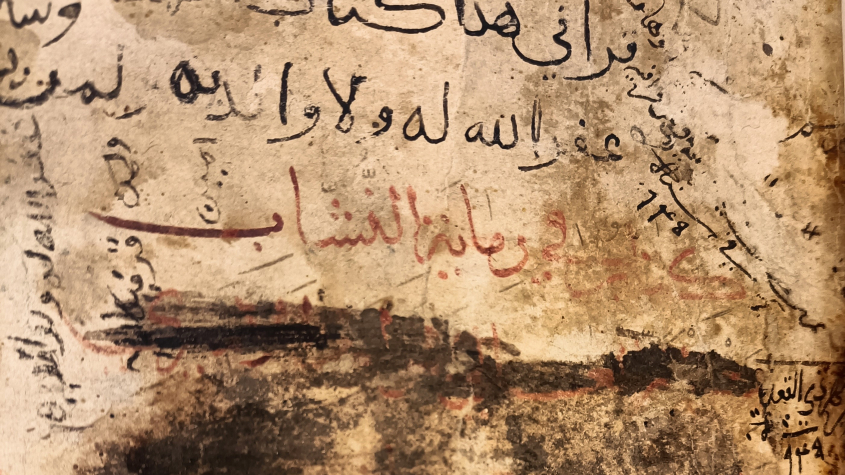 Public Domain
Public Domain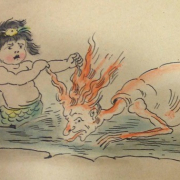 Public Domain
Public Domain


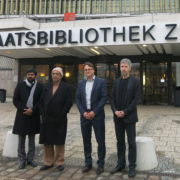
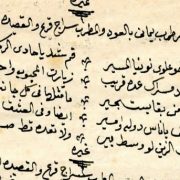

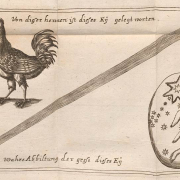


Ihr Kommentar
An Diskussion beteiligen?Hinterlassen Sie uns einen Kommentar!